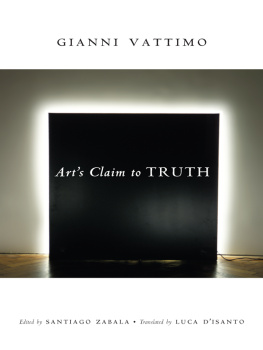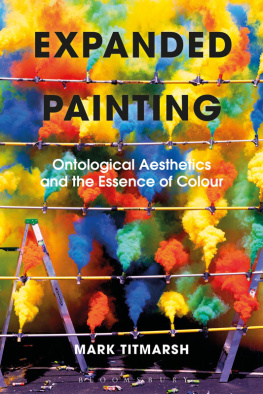ARTS CLAIM TO TRUTH
Columbia Themes in Philosophy, Social Criticism, and the Arts
COLUMBIA THEMES IN PHILOSOPHY, SOCIAL CRITICISM, AND THE ARTS PRESENTS monographs, essay collections, and short books on philosophy and aesthetic theory. It aims to publish books that show the ability of the arts to stimulate critical reflection on modern and contemporary social, political, and cultural life. Art is not now, if it ever was, a realm of human activity independent of the complex realities of social organization and change, political authority and antagonism, cultural domination and resistance. The possibilities of critical thought embedded in the arts are most fruitfully expressed when addressed to readers across the various fields of social and humanistic inquiry. The idea of philosophy in the series title ought to be understood, therefore, to embrace forms of discussion that begin where mere academic expertise exhausts itself, where the rules of social, political, and cultural practice are both affirmed and challenged, and where new thinking takes place. The series does not privilege any particular art, nor does it ask for the arts to be mutually isolated. The series encourages writing from the many fields of thoughtful and critical inquiry.
Lydia Goehr and Daniel Herwitz, eds., The Don Giovanni Moment: Essays on the Legacy of an Opera
Robert Hullot-Kentor, Things Beyond Resemblance: Collected Essays on Theodor W. Adorno
John T. Hamilton, Music, Madness, and the Unworking of Language
Arts Claim to Truth
GIANNI VATTIMO
Edited by Santiago ZabalaTranslated by Luca DIsanto
COLUMBIA UNIVERSITY PRESS NEW YORK
COLUMBIA UNIVERSITY PRESS
Publishers Since 1893
NEW YORK CHICHESTER, WEST SUSSEX
cup.columbia.edu
Originally published in Italian as Poesia e ontologia
Copyright 1985 Ugo Mursia Editore S.p.A
Translation copyright 2008 Columbia University Press Paperback edition, 2010
All rights reserved
E-ISBN 978-0-231-51566-5
Library of Congress Cataloging-in-Publication Data
Vattimo, Gianni, 1936
[Poesia e ontologia. English]
Arts claim to truth / Gianni Vattimo ; edited by Santiago Zabala;
translated by Luca DIsanto.
p. cm.(Columbia themes in philosophy, social criticism, and the arts)
Includes bibliographical references and index.
ISBN 978-0-231-13850-5 (cloth : alk. paper)ISBN 978-0-231-13851-2 (pbk. : alk paper)ISBN 978-0-231-51566-5 (ebook)
1. Aesthetics. 2. Ontology. 3. Poetry. I. Zabala, Santiago, 1975II. Title. III. Series.
BH39.V34 13 2008
111.85dc22
2007041079
A Columbia University Press E-book.
CUP would be pleased to hear about your reading experience with this e-book at .
References to Internet Web sites (URLs) were accurate at the time of writing. Neither the author nor Columbia University Press is responsible for URLs that may have expired or changed since the manuscript was prepared.
For Richard Rorty
Contents
I would like to thank Luca DIsanto for the extraordinary translation and Michael Haskell for helping me, once again, in revising the whole text. Special thanks go to Mario Cedrini, Ana Messuti, Alberto Martinengo, Wendy Lochner, and Robert Valgenti for their help throughout the various phases of the production of the book.
Pareyson dallestetica allontologia was originally published in Rivista di estetica 4041 (1993): 317; and Arte, la verit ti fa male, lo sai, in La Stampa, 12 July 2005.
Gianni Vattimo sees the phenomena which Hans Belting and I address from a perspective wider by far than either of us occupies: he thinks of the end of art under the perspective of the death of metaphysics in general, as well as of certain philosophical responses to aesthetic problems raised by a technologically advanced society.
Arthur C. Danto, After the End of Art (1997)
The recent publication of Weakening Philosophy: Essays in Honour of Gianni Vattimo has induced us to translate and publish this early book of Vattimos because the festschrift confirms not only that the Italian intellectual is one of the most important living philosophers but also that his early works deserve to be presented to Anglo-Saxon readers as much his later ones. During these years, Vattimo taught aesthetics in the University of Turin and published many books on Nietzsche, Heidegger, and aesthetics that laid the way for all these better known later texts and, most of all, for the formulation of his philosophy: pensiero debole, weak thought, which he first expounded in 1979. Weak thought is nothing other than the knowledge, acceptance, and recognition that philosophy, after the deconstruction of metaphysics, cannot capture the ultimate essence of its objects but must comply with a multiplicity of interpretations. As for religion, weak thought helps us to deal with the consequences and obligations of the death of God, that is, to weaken those ecclesiastic dogmas that stand as obstacles to the faith of believers and the agnosticism of nonbelievers. But how did Vattimo reunderstand philosophy as the modern description of static essences in order to recognize its postmodern, interpretative nature?
The answer to this question can only be found in those early texts by Vattimo, such as Arts Claim to Truth and the recently collected and translated Dialogue with Nietzsche, where weak thought took shape through an accurate analysis of Nietzsche, Heidegger, Luigi Pareyson, and Hans-Georg Gadamer, who have always been at the center of Vattimos intellectual career. But the current study on aesthetics not only prepares for weak thought and the well-known postmetaphysical interpretation of religion but also delineates, for the first time, Vattimos own aesthetics, which is hardly known to the English-speaking audiences. Just like Dialogue with Nietzsche, Arts Claim to Truth is not simply a translation of the second edition of Gianni Vattimos Poesia e ontologia of 1967, but a new edition, with two new chapters and a new order given to the original contents. All this has been done, with Vattimos consent, because we felt the new chapters allowed a division of the book into three parts, Aesthetics, Hermeneutics, and Truth, which indicate and constitute the core of Vattimos aesthetic philosophy.
The best introductions to edited books are not those that summarize for the reader what she is about to read, but the ones that enable the reader to familiarize herself with the themes, authors, and vocabularies that constitute not only the structure of the book but also its thesis. This is valid not only for those introductions written by a collections author (as in Vattimos Nihilism and Emancipation), These artists works are not only good examples for the reader to keep in mind in the different parts of the book (the Fountain for Heideggers ontological bearing of art, Mulholland Drive for arts interpretative form according to Pareyson, and Let There Be Light for Gadamers truth of art), but also indications that arts function is not to fulfill, perform, or entertain the demands of the public but, on the contrary, to require from the public an interpretation that allows the works ontological truth to come out, hence, truth as the hermeneutic consequence of arts ontological bearing.
Although there have been many different theories of aesthetics since Alexander Baumgarten first gave the concept a modern meaning in 1735, most of them have either been limited to a philosophy of art or to the aesthetic nature of objects that are not art. This same distinction has been further divided in representationalism and formalism. This book situates itself beyond both understandings of aesthetics and, more important, as Arthur C. Danto correctly observes in my epigraph, under the perspective of the end of metaphysics. when the artist lost that direct contact with the restricted public that used to commission his works. In other words, for Vattimo the end of metaphysics also depends on the philosophical responses raised by its society or, as Danto says, by that technological society it inhabits. But how did Vattimo acquire this postmetaphysical perspective from Heidegger?














